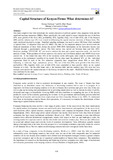| dc.description.abstract | The study sought to find what determines the capital structures of publicly quoted firms, unquoted firms and the small and medium enterprises (SMEs). More specifically, the study aimed to assess whether the size of the firm (FS), asset growth of the firm (AG), profitability (PR), liquidity (LQ), cost of debt (CD), risk of the business (BR) and the industry type (IN) were crucial in influencing the capital structure decisions of Kenya firms. The study employed descriptive design. Stratified sampling technique was used to select 200 firms which included 22 quoted firms, 25 unquoted firms and 153 SMEs. The data for the empirical analysis were derived from the financial statements of these firms during the period 2000–2010. Information on the heterodox factors was obtained through a questionnaire survey. The field survey was carried out between June and July 2012. Statistical package “STATA/IC 10” was used to analyze the data and a panel regression model was used for analysis of data. Wald goodness-of-fit test statistics was carried out. Correlation analysis and ANOVA test were carried out. It was found that only 36% of the variations in the debt-equity ratio could be explained by the variations in the explanatory variables of the model. On the other hand, the adjusted R2 s of the individual regressions fitted in each of the five industries separately have ranged from about 50% to over 80%, indicating a relatively high explanatory power. The size of the firm (FS), asset growth of the firm (AG), profitability (PR), liquidity (LQ), cost of debt (CD) were concluded to have positive effect on the capital structure of a firm. On the other hand, risk of the business (BR) and the industry type (IN) were not very strongly correlated to the capital structure of the firm as revealed by the study. Modified Pecking Order theory was confirmed by the study. | en_US |

